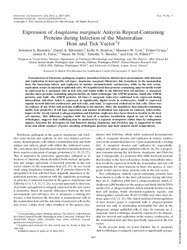| dc.contributor.author | Ramabu, Solomon Stephen | |
| dc.contributor.author | Schneider, David A. | |
| dc.contributor.author | Brayton, Kelly A. | |
| dc.contributor.author | Ueti, Massaro W. | |
| dc.contributor.author | Grac¸a, Telmo | |
| dc.contributor.author | Futse, James E. | |
| dc.contributor.author | Noh, Susan M. | |
| dc.contributor.author | Baszler, Timothy V. | |
| dc.contributor.author | Palmer, Guy H. | |
| dc.date.accessioned | 2021-11-16T14:00:49Z | |
| dc.date.available | 2021-11-16T14:00:49Z | |
| dc.date.issued | 2011 | |
| dc.identifier.citation | Ramabu, S. S., Schneider, D. A., Brayton, K. A., Ueti, M. W., Graça, T., Futse, J. E., ... & Palmer, G. H. (2011). Expression of Anaplasma marginale ankyrin repeat-containing proteins during infection of the mammalian host and tick vector. Infection and immunity, 79(7), 2847-2855. | en_US |
| dc.identifier.issn | 1098-5522 | |
| dc.identifier.uri | https://journals.asm.org/doi/full/10.1128/IAI.05097-11 | |
| dc.identifier.uri | http://researchhub.buan.ac.bw:80/handle/123456789/80 | |
| dc.description.abstract | Transmission of tick-borne pathogens requires transition between distinct host environments with infection and replication in host-specific cell types. Anaplasma marginale illustrates this transition: in the mammalian host, the bacterium infects and replicates in mature (nonnucleated) erythrocytes, while in the tick vector, replication occurs in nucleated epithelial cells. We hypothesized that proteins containing ankyrin motifs would be expressed by A. marginale only in tick cells and would traffic to the infected host cell nucleus. A. marginale encodes three proteins containing ankyrin motifs, an AnkA orthologue (the AM705 protein), AnkB (the AM926 protein), and AnkC (the AM638 protein). All three A. marginale Anks were confirmed to be expressed during intracellular infection: AnkA is expressed at significantly higher levels in erythrocytes, AnkB is expressed equally by both infected erythrocytes and tick cells, and AnkC is expressed exclusively in tick cells. There was no evidence of any of the Ank proteins trafficking to the nucleus. Thus, the hypothesis that ankyrin-containing motifs were predictive of cell type expression and nuclear localization was rejected. In contrast, AnkA orthologues in the closely related A. phagocytophilum and Ehrlichia chaffeensis have been shown to localize to the host cell nucleus. This difference, together with the lack of a nuclear localization signal in any of the AnkA orthologues, suggests that trafficking may be mediated by a separate transporter rather than by endogenous signals. Selection for divergence in Ank function among Anaplasma and Ehrlichia spp. is supported by both locus and allelic analyses of genes encoding orthologous proteins and their ankyrin motif compositions. | en_US |
| dc.language.iso | en | en_US |
| dc.publisher | American Society for Microbiology | en_US |
| dc.relation.ispartofseries | Infection and Immunity;July 2011, 2847–2855 | |
| dc.subject | Anaplasma | en_US |
| dc.subject | Marginale Ankyrin Repeat | en_US |
| dc.title | xpression of Anaplasma marginale Ankyrin Repeat-Containing Proteins during Infection of the Mammalian Host and Tick Vector | en_US |
| dc.type | Article | en_US |

